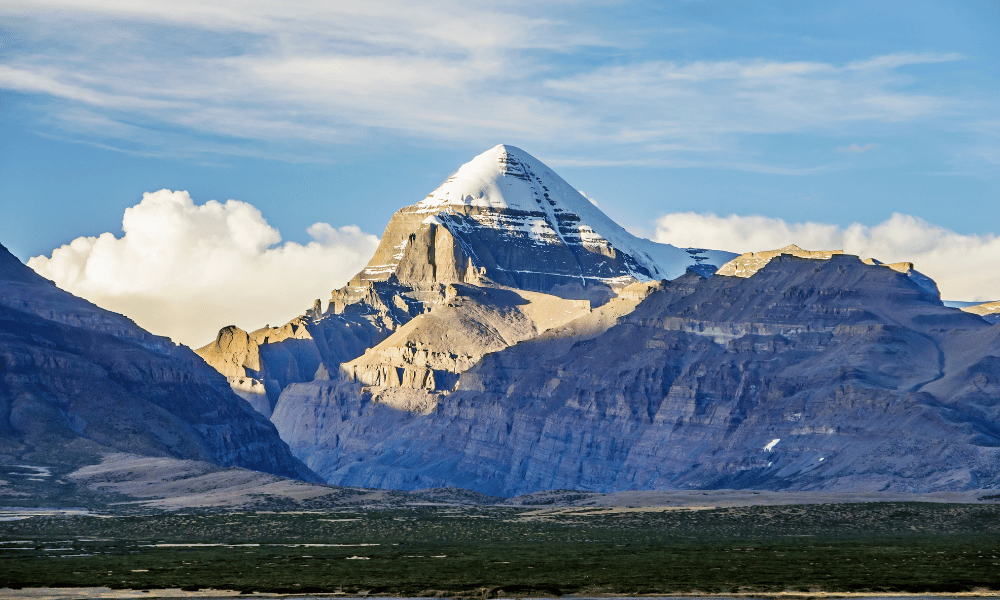Kailash Parvat, popularly known as Mount Kailash, demands attention not just for its towering height of 6,638 meters but also for its revered location in the Himalayas. Located close to the holy Mansarovar Lake in the remote southwest region of Tibet, this magnificent peak stands at the crossroads of spirituality and natural treasures.
Kailash Parvat, revered as Lord Shiva's residence in Hinduism, draws pilgrims from many faiths, including Buddhism, Jainism, and the Bon religion. A sacred pilgrimage, the Kailash Parikrama, a circumambulation around its base, offers stunning views of the surrounding surroundings.
Join us on this blog to capture the unfathomable allure of Kailash Parvat, a sanctuary where spirituality meets natural grandeur and the echoes of ancient traditions resonate in the clear mountain air. Discover the spiritual tapestry woven into the fabric of this unique site, where faith and nature meet on the world's roof.
Also Read: What Is Kailash Mansarovar Yartra?
Photos of Kailash Parvat
Here are some photographs of Kailash Parvat that capture the majesty of this revered Himalayan peak. These photographs, which range from the towering curves of the mountain to the reflecting tranquility of Mansarovar Lake, provide a glimpse into the spiritual journey and natural magnificence that make Kailash a truly exceptional location. Immerse yourself in this holy sanctuary's visual narrative.
Kailash East Face
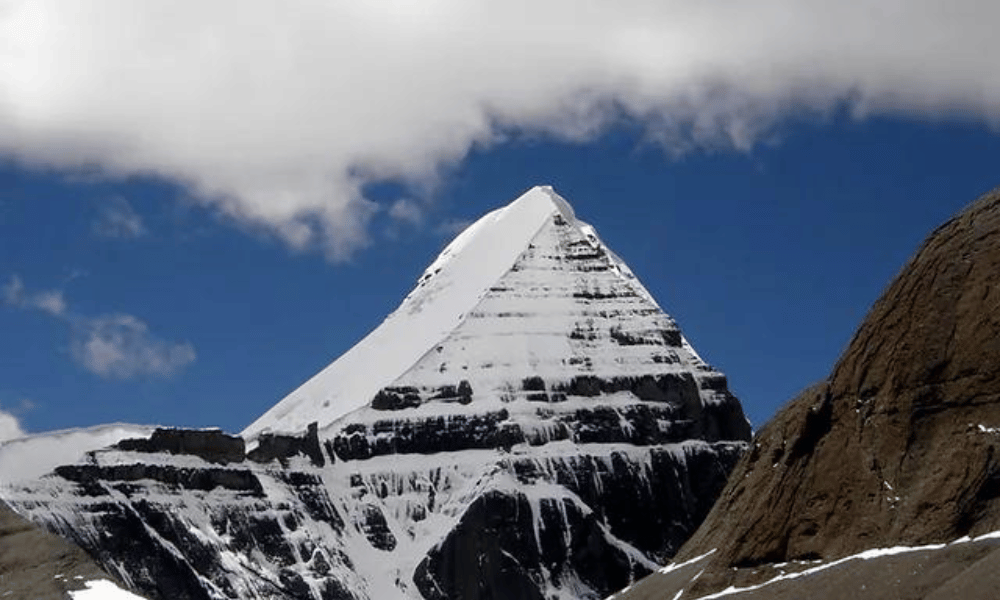
Believed to be composed of Crystal, it is as though the very heart of Mount Kailash is encapsulated within this face. The East face of Mount Kailash is visible during the Inner Kora. The moment the western face of Mount Kailash stops showing its appearance, its east face starts taking the scene. The Eastern face is visible till a smaller distance after reaching Gauri Kund. Later on, the view starts diminishing and starts to hide behind other mountain peaks.
Kailash West Face
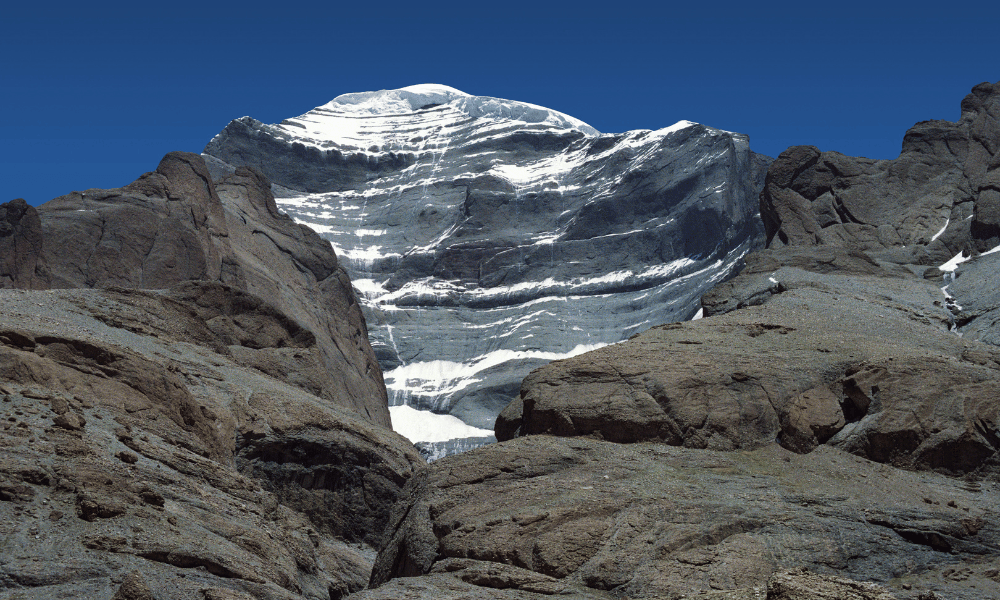
While continuing your Kailash Manasarovar Trek towards Dirapuk, you will be able to see the West face of Mount Kailash. During your journey, you’ll be facilitated with a halt in the midway and from here you will clearly see the west face of Mount Kailash. The West Face, believed to be adorned with the precious gemstone Ruby, emanates an atmosphere of compassion and benevolence. As you continue with the trek, the view will stop and the eastern side will replace the scene.
Kailash North Face
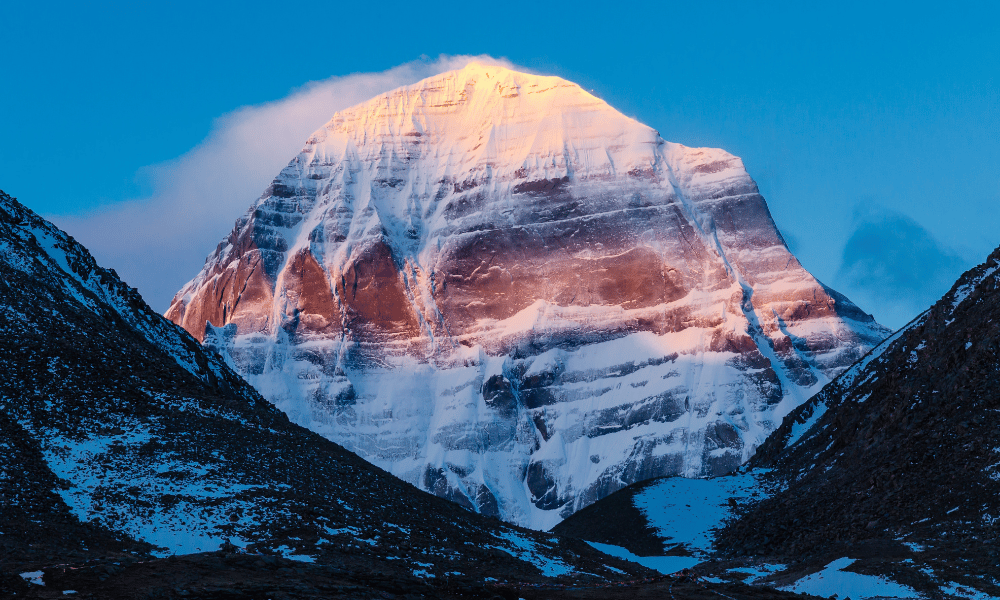
The northern face of Mount Kailash is characterized by its formidable cliffs and dramatic rock formations. It is the most widely known face of Kailash since it is the one you will mostly see in the collection of photographs on many magazines and websites. It is like a symbol for the Kailash Yatra. This face is the one which is said to be attracting devotees from all over to embark on this journey around Mount Kailash. This face showcases the brighter side of the mountain when the sun rays fall on its surface.
Kailash South Face

The southern face of Kailash is known for its smoother, comparatively gentler slopes. Pilgrims on the Kailash Parikrama, the sacred circumambulation, often catch their first glimpse of the southern face as they approach from the Barkha plain. It will showcase the backside of the massive mountain and a long line seen passing from the head to the base of the snow-covered mountain, shaped like a spine, is believed to be the spine of Lord Shiva by the Hindu pilgrims. When the snow melts, the spine-path paves the way to be gathered at the Athmalingam.
Golden Kailash
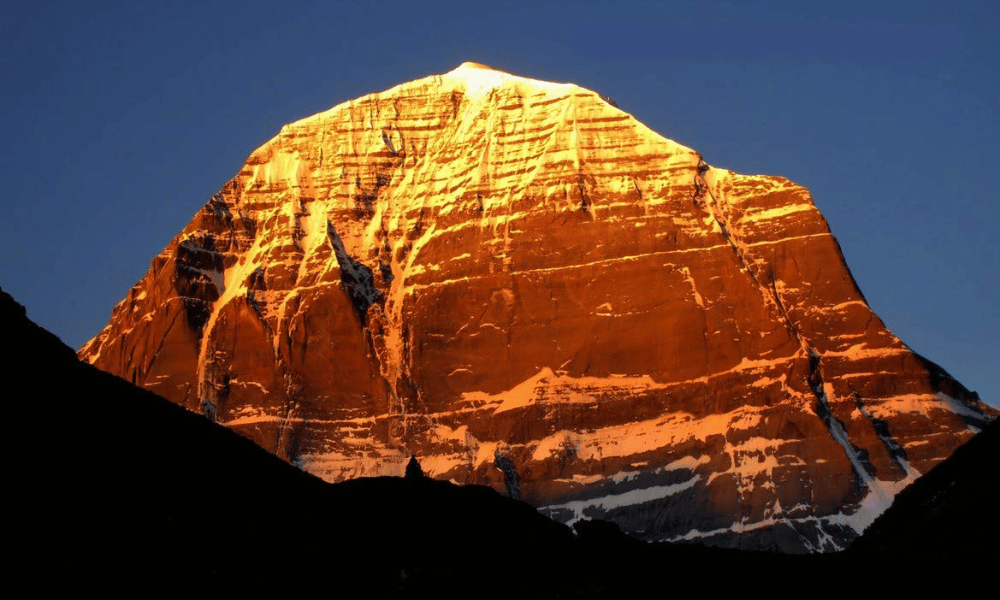
As the first light of dawn breaks, the eastern face of Kailash gradually emerges from the night's shadows, revealing the intricate details of its rugged terrain. The entire landscape comes alive with a golden glow, symbolizing not just the beginning of a new day but also the awakening of a profound spiritual journey. The Golden Kailash is born when the sun's rays fall on the east face of Mount Kailash, illuminating it with a golden tint, giving the impression of the Golden Kailash. The golden Kailash is a breathtaking sight to see during your Kailash Yatra.
Kailash Aerial View

This is the aerial view of Mount Kailash. Lord Shiva, along with Mata Parvati, is said to reside at the top of the Kailash mountain. One fact regarding Mount Kailash is that no one has ever reached the summit due to various reasons.
Kailash and Lake Mansarovar

At 6,638 meters high, Mount Kailash is a holy peak in Hinduism, Buddhism, Jainism, and the Bon faith. Along with the peaceful Mansarovar Lake, this Tibetan region is a place where many people go on spiritual journeys. Walking around Kailash and taking symbolic dips in Mansarovar are very important practices that draw both pilgrims and nature lovers.
Learn More: Lake Mansarovar
Kailash From Tibet

When you look at Mount Kailash from Tibet, it's an amazing sight of great beauty. At 6,638 meters, the sacred peak stands out in the scenery with its rough cliffs and grand presence. From Tibet, you can see the eastern face of Kailash. As the sun moves across its surface, it shows off all of its fine features. Mount Kailash is a deep and amazing sight that draws in pilgrims, trekkers, and visitors alike. It is surrounded by the peaceful beauty of the Tibetan Plateau.
Kailash During Winter

In the winter, Mount Kailash turns into a peaceful, snow-covered landscape that adds to the peace of its holy surroundings. A blanket of snow softens the rough edges of the mountain, making for a beautiful and surreal scene. There is a peaceful, one-color beauty to the whole area, including Mansarovar Lake and the land around it. The white expanse makes the spot even more holy.
Kailash During Summer
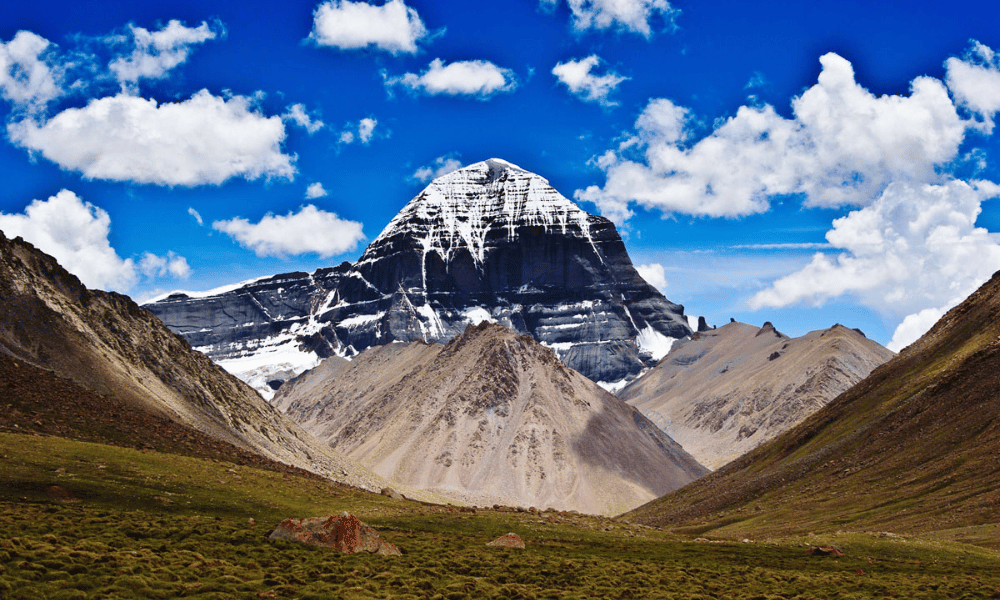
During the summer, Mount Kailash undergoes a transformation as the harsh winter conditions give way to milder temperatures. The rugged terrain of the sacred mountain becomes more accessible, and the landscape around Mount Kailash comes alive with vibrant colors.
Kailash At Night Time

During the night, Mount Kailash takes on a different character, bathed in the soft glow of moonlight and surrounded by a canvas of stars. The sacred peak, often shrouded in darkness, becomes a silhouette against the night sky, creating a profoundly serene and mystical atmosphere. On clear nights, the stars blanket the heavens, creating a celestial backdrop to the sacred mountain.
Kailash Gauri Kund
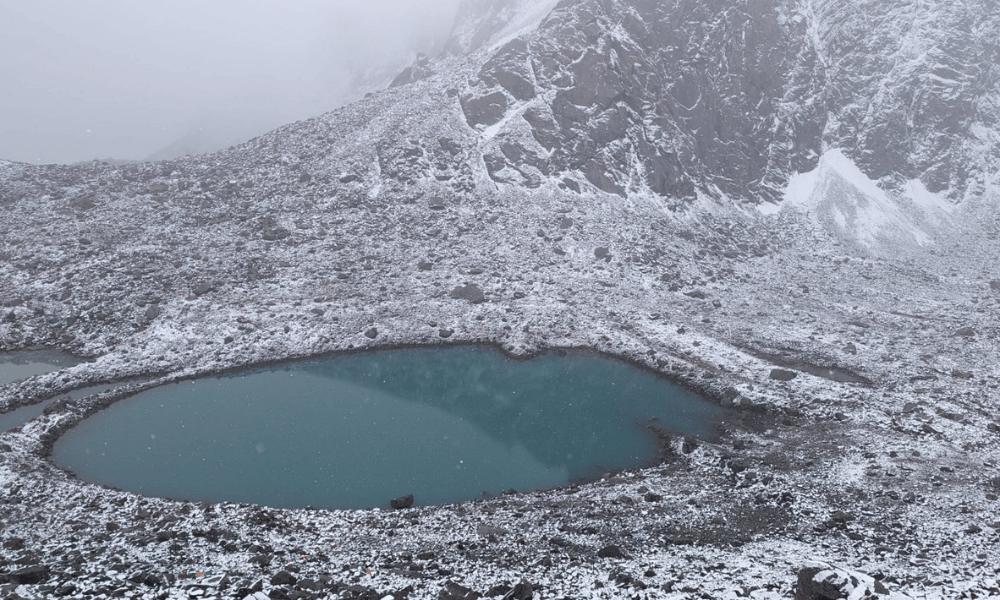
Gauri Kund, located in the vicinity of Mount Kailash and Lake Mansarovar, is a sacred water body with deep spiritual significance. Named after Goddess Parvati (Gauri), it is believed to be the bathing place of the Goddess. Pilgrims on the Kailash Mansarovar Yatra often take a dip in Gauri Kund, considering it purifying and spiritually enriching. The pristine waters and the serene surroundings contribute to the mystical aura of this revered site, making it an integral part of the sacred pilgrimage experience.
Saga Dawa Festival
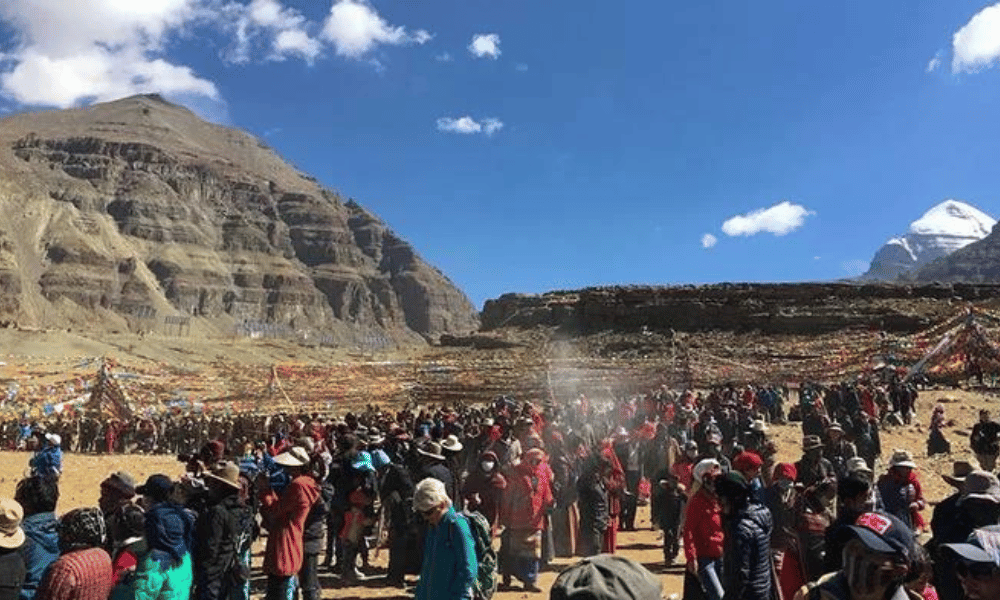
Saga Dawa, celebrated at Mount Kailash, marks the birth, enlightenment, and parinirvana (passing) of Lord Buddha. During this Tibetan Buddhist festival, pilgrims engage in prayer, circumambulate the sacred mountain, and perform acts of kindness. The highlight is the raising of prayer flags and the lighting of butter lamps to symbolize enlightenment. Saga Dawa is considered an auspicious time, believed to amplify the positive effects of virtuous deeds. Pilgrims from various Buddhist traditions gather to partake in the festivities, fostering a sense of spiritual unity.
Kailash View From Chuku Monastery

Chuku Monastery, also known as Chiu Gompa, is a Tibetan Buddhist monastery located near Mount Kailash in Tibet. Situated on the northwestern shore of Lake Mansarovar, Chuku Monastery is a sacred site and a destination for pilgrims undertaking the Kailash Parikrama. The monastery offers stunning views of Mount Kailash and the surrounding Himalayan landscape. Pilgrims often visit Chuku Monastery to seek blessings, perform rituals, and experience the spiritual ambiance of this revered location.
Our Packages
Here are our most popular packages for Kailash Mansarovar Yatra.
Kailash Mansarovar Yatra by Helicopter Itinerary
|
Kailash Mansarovar Yatra by Helicopter |
|
Day 01: Kathmandu Arrival. |
|
Day 02: Kathmandu Sightseeing. (You will apply your visa today) |
|
Day 03: Bhaktapur and Patan Sightseeing. |
|
Day 04: Chandragiri Sightseeing. |
|
Day 05: Fly to Nepalgunj. (Receive your visa today) |
|
Day 06: Fly from Nepalgunj to Simikot. (2910 m) |
|
Day 07: Simikot - Hilsa - Taklakot. (4025 m) |
|
Day 08: At Taklakot – Rest Day Full Day – Free for acclimatization. |
|
Day 09: Drive from Taklakot to Lake Mansarovar. (4550 m) |
|
Day 10: Drive to Yama Dwara Trek to Deruphuk. (4909 m) - 12 KM |
|
Day 11: Trek to Zuthulphuk. (4820 m) 4760 m) (22 KM Trek) |
|
Day 12: Zutulphuk to Hilsa or Simikot. (8 KM Trek) |
|
Day 13: Hilsa to Simikot, fly to Nepalgunj and fly back to Kathmandu. |
|
Day 14: Transfer to Airport. |
Learn More: Kailash Mansarovar Yatra by Helicopter
Kailash Mansarovar Yatra via Kyirong
|
Kailash Mansarovar Yatra via Kyirong |
|
Day 01: Kathmandu Arrival. |
|
Day 02: Kathmandu Sightseeing. (Your visa will be applied today) |
|
Day 03: Kathmandu Sightseeing. |
|
Day 04: Kathmandu Sightseeing. |
|
Day 05: Bhaktapur Sightseeing. |
|
Day 06: Drive to Syabru Besi/Rasuwa Gadhi, or you can fly by a chartered helicopter. |
|
Day 07: Border formalities and stay in Kyirong. |
|
Day 08: Kyirong to Saga. (220 KM) |
|
Day 09: Saga to Lake Mansarovar. (450 KM) |
|
Day 10: Drive to Darchen. (4650 m) - 35 KM |
|
Day 11: Drive to Yama Dwara Trek to Deruphuk. (4909 m) - 12 KM |
|
Day 12: Trek to Zuthulphuk. (4820 m) 4760 m) (22 KM) |
|
Day 13: Zutulphuk to Saga. (8 KM Trek and 470 KM Drive - 8 Hours) |
|
Day 14: Drive back to Kyirong. (2850M) |
|
Day 15: Drive to Kathmandu. (1400m) (160 KM) or fly back by a chartered helicopter. |
|
Day 16: Departure. |
Learn More: Kailash Mansarovar Yatra by Drive via Kyirong
Conclusion
As this visual journey around the holy Mount Kailash comes to a close, we find ourselves at the point where spirituality and natural beauty intersect. The deep beauty, cultural wealth, and spiritual resonance of this Himalayan sanctuary can be seen in every picture on this blog. Every picture tells a story of a journey, a moment of thought, or awe, from the majesty of Kailash to the peace of Mansarovar.
As the sun goes down behind the tall peaks and casts its golden light on the rough terrain, and as the stars light up the sky above Mount Kailash at night, we are reminded of the ancient allure that brings travelers and seekers to this holy place. The picture blog captures moments of devotion, the way light and shadow play off of old rocks, and the peace of the Himalayas.
May these pictures stay with you, reminding you of the sounds of a spiritual trip that goes beyond the physical and calling you to start your own pilgrimage, whether you go in person or in spirit. With its deep mystery, Mount Kailash shines like a beacon, beckoning us to connect with God, enjoy the beauty of the Earth, and explore the endless landscapes of our own inner retreats.
Related Read: Best Time To Visit Kailash Mansarovar Yatra

